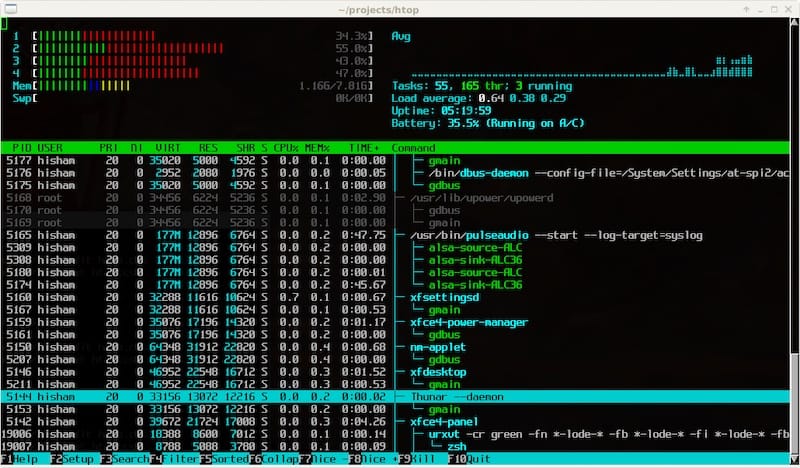How To Install Htop on openSUSE

In this tutorial, we will show you how to install Htop on openSUSE. Htop is an enhanced version of the classic top command, offering an interactive, real-time view of your Linux system’s processes and resource utilization. With its user-friendly, ncurses-based interface, htop presents a wealth of information in a clear and easily digestible format. One of the standout features of htop is its tree view, which displays processes in a hierarchical structure, making it easy to identify parent-child relationships and resource consumption across process threads.
In addition to the tree view, htop offers color-coding to quickly distinguish between different process states (e.g., running, sleeping, zombies). Users can easily sort processes based on various metrics such as CPU usage, memory consumption, and runtime. Htop also provides convenient keyboard shortcuts for actions like searching, filtering, and sending signals to processes, making it a breeze to manage your system’s workload.
This article assumes you have at least basic knowledge of Linux, know how to use the shell, and most importantly, you host your site on your own VPS. The installation is quite simple and assumes you are running in the root account, if not you may need to add ‘sudo‘ to the commands to get root privileges. I will show you the step-by-step installation of the Htop interactive process viewer on openSUSE.
Prerequisites
- A server running one of the following operating systems: openSUSE (Leap or Tumbleweed)
- Familiarity with basic Linux commands and openSUSE’s package management system (
zypper) is also beneficial, as you’ll be interacting with the command line during the installation process. - You will need access to the terminal to execute commands. openSUSE provides the Terminal application for this purpose. It can be found in your Applications menu.
- You’ll need an active internet connection to download Htop and its dependencies.
- You’ll need administrative (root) access or a user account with sudo privileges.
Install Htop on openSUSE
Step 1. Update the package repositories to ensure you have access to the latest software versions:
sudo zypper refresh sudo zypper update
Step 2. Installing Htop on openSUSE.
- Installing htop using Zypper
Zypper is openSUSE’s command-line package manager, offering a simple and efficient way to install, update, and remove software packages. To install htop using zypper, follow these steps:
sudo zypper install htop
Zypper will resolve any dependencies and prompt you to confirm the installation. Press “y” to proceed.
- Installing htop from source
In some cases, you may prefer to compile htop from source, particularly if you need features not available in the packaged version or want to customize the installation. Here’s how to compile and install htop from source on openSUSE:
First, install the necessary development tools and dependencies:
sudo zypper install gcc make ncurses-devel git
Clone the htop source code repository from GitHub:
git clone https://github.com/htop-dev/htop.git
Navigate to the cloned directory:
cd htop
Run the configure script to prepare the build environment:
./configure
Compile the source code using make:
make
Install the compiled htop binary and man page:
sudo make install
Step 3. Accessing Htop on openSUSE.
Once the installation is complete, you can launch htop by simply typing htop in the terminal and pressing Enter.

Step 4. Basic usage guide.
Now that you have htop installed on your openSUSE system, let’s explore its basic usage and features. Launch htop by typing htop in the terminal and pressing Enter. The htop interface consists of three main sections:
- Header: Displays system summary information, such as CPU and memory usage, uptime, and load averages.
- Meters: Shows real-time graphs for CPU, memory, and swap usage.
- Process list: Presents a list of running processes with details like PID, user, CPU and memory usage, and command.
To navigate and interact with htop, use the following keyboard shortcuts:
- Arrow keys: Scroll through the process list.
- F1: Access the help screen.
- F2: Open the setup menu to customize htop’s display and color settings.
- F3: Search for a process by name or PID.
- F4: Filter processes based on various criteria (e.g., user, command, or CPU usage).
- F5: Toggle tree view mode.
- F6: Sort processes by a specific column (e.g., CPU or memory usage).
- F7 and F8: Decrease and increase the process niceness value (priority).
- F9: Send a signal to the selected process (e.g., SIGTERM or SIGKILL).
- F10 or q: Quit htop.
To kill a process using htop, select the process with the arrow keys and press F9. Choose the desired signal (e.g., SIGTERM for a graceful exit or SIGKILL for an immediate termination) and press Enter to send the signal.
Congratulations! You have successfully installed Htop. Thanks for using this tutorial for installing Htop interactive process viewer on your openSUSE system. For additional or useful information, we recommend you check the official Htop website.